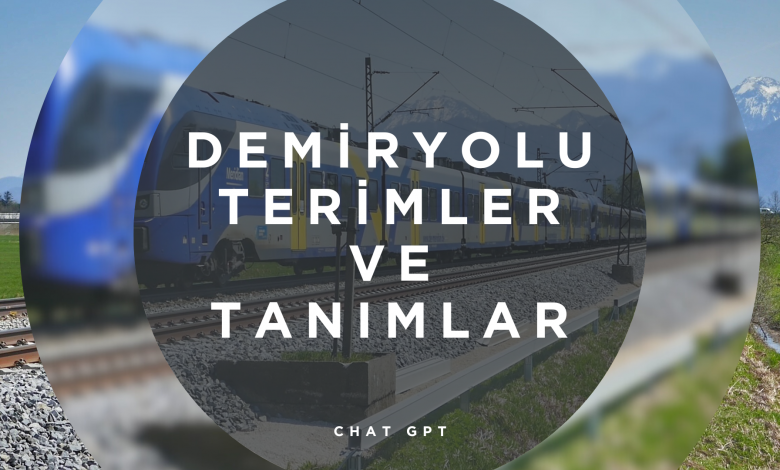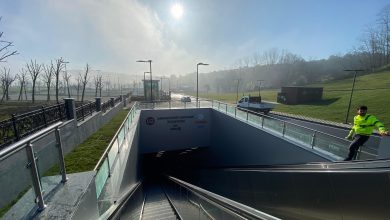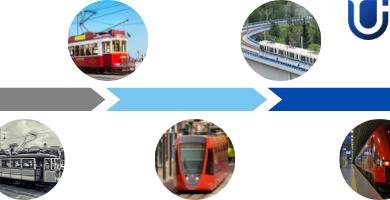RAILWAYS – Terms and Definitions

Railway transport is a type of transport on railway lines to transport freight and passengers. Rail transport stands out as a fast, safe and environmentally friendly transportation option.
Some of the advantages of rail transport are:
• Capable of handling large volumes of cargo effectively.
• It consumes less fuel compared to other transportation modes due to its energy efficiency.
• Causes less traffic jams compared to road traffic.
• It creates less environmental pollution and helps to reduce greenhouse gas emissions.
• It provides an economical option by reducing transportation costs.
However, rail transport also has disadvantages:
• Rail lines are limited and located in certain areas, so there may be a lack of direct connections.
• In passenger transport, it may not be able to provide point-to-point service and additional means of transport may be required.
• In some areas, the infrastructure costs of the rail network may be high.
In general, rail transport is an important transport option around the world due to its various advantages and continues to be developed continuously.
MAIN CONCEPTS OF RAILWAYS
The main factors that form and shape railway transport:
Railway Lines: It is the basic building block of railway transport. Railway lines are the rails and their connections that make up the railway network. These lines connect different cities, regions and countries and determine the routes through which transportation is made.
Wagons and Types of Wagons: There are different types of wagons used in freight transportation. Container wagons are an important type of wagon that increases the carrying capacity and helps the cargo to be transported more regularly. There are also passenger wagons used in passenger transportation.
Loco-motifs:In rail transport, powerful locomotives are used to pull trains. These locomotives provide the necessary power to move and accelerate trains.
Infrastructure and Stations: Appropriate infrastructure and stations are important for rail transport. Stations are used to embark, disembark and transfer passengers and cargo. There are also maintenance and logistics centers for train maintenance and route change.
Security Systems: Safety is of great importance in railway transportation. The safety system ensures that trains travel safely and the risk of accidents is reduced. Safety measures such as signaling and automatic braking systems are used.
Logistics and Management:Logistics and management processes are important for the efficient management of rail transport. Effective management is required for the transport, tracking, coordination and on-time delivery of loads.
Technological Developments: Railway transportation is a sector open to technological developments. Innovations such as digitization, automation and high-speed rail technology are important to increase the efficiency of rail transport and shape its future potential.
RAILWAY TERMINOLOGY
These factors are important factors that determine the functioning and development of rail transport. Each contributes to a more efficient and sustainable rail transport system.
Railroad: A transportation system used to transport passengers and cargo on rails.
Rail: The basic building block of a railroad track is a metal strip and provides the path on which the train wheels move.
locomotive: A powerful motor vehicle that pulls the train.
Wagon: Vehicles designed to carry passengers or cargo.
Passenger Wagon: A wagon that carries passengers and provides comfortable travel.
Freight Wagon: A wagon in which cargoes are transported and which contain various types of cargo.
Container Wagon:A specially designed wagon where containers are transported.
Station: The place where trains stop, passengers get on and off and loads are transferred.
Platform: The elevated platform used to embark and disembark trains at the station.
Signaling: A system that regulates train movements and ensures safety.
Freight Transport: The process of transporting cargo on the railway.
Truss: The connection point used to connect and direct the railway lines and the superstructure element located at this point.
Grounding: The process of connecting the rails to the ground to regulate the electric current and provide safety.
Transcontinental Railroad: Transcontinental long-distance rail line.
Freight Car Capacity: The amount of cargo that can be carried in a freight car.
Passenger Car Capacity: The number of passengers that can be carried in a passenger car.
RAILWAY SUPERSTRUCTURE ELEMENTS
The railway superstructure includes the main elements that make up the basic components of the railway line. Here are the definitions of the main elements that make up the superstructure of the railway:
Rails: Metal strips, the most basic element of the railway line. Rails are the main carriers of the superstructure and allow the train wheels to move on it.
Traverse: It is wooden or concrete blocks placed under the rails and adjusting the distance between the rails. It ensures that the rails are placed and fixed properly.
Fasteners: These are the connecting elements used to fix the rails to each other, to the sleeper and/or to the existing superstructure system.
Ballast: Crushed stone filling layer placed under the rails. Ballast supports the ground and provides water drainage, increasing the stability and durability of the track track.
Infill Ground: The ground section created to improve the existing ground so that it can support the railway track superstructure and vehicles.
Culverts: Pipes or channels used to control the flow of water and to pass the water passing under the railway line.
Signaling and Communication Systems: These are the signaling devices and communication systems used to regulate railway traffic and provide security.
Electrification System: These are electrification systems such as catenary or third rail used to meet the energy needs of electric trains.
The railway superstructure is formed by the harmonious combination of all these elements. These elements ensure the safe, durable and efficient functioning of the rail line and enable the rail transport to be carried out effectively.

